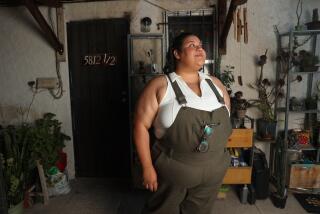L.A. Apartment Construction Up 65%
- Share via
Construction of apartments is up nearly 65% in Los Angeles County this year and 85% in Orange County, suggesting that the region is headed for one of its biggest years of apartment building since construction of multifamily housing nearly ground to a halt in 1993.
But the number of units heading to market doesn’t begin to approach the construction levels of earlier real estate booms and is far off the pace government planners say is necessary to house the area’s burgeoning population.
Developers obtained permits for 4,036 multifamily housing units in Los Angeles County during the first half of this year, compared with 2,450 for the first six months of 1999, according to the Burbank-based Construction Industry Research Board. During the same period, the number of multifamily housing permits issued in Orange County rose to 4,157, compared with 2,246 for the first six months of 1999.
The new apartments provide some relief for Southern California’s growing population. In the last three years, Los Angeles County has added more than 500,000 residents and Orange County took in 200,000, the state Department of Finance reports.
“We see great potential in Los Angeles [for more apartment construction] because of that demand,” said Art Lomenick, a Dallas-based senior executive vice president with Atlanta-based Post Properties, a real estate investment trust that is building apartments in a number of markets throughout the country.
Post’s Southern California projects include 400 units it plans to build at Paseo Colorado, a shopping center and apartment project in downtown Pasadena in cooperation with developer Trizec-Hahn, plus up to 1,000 units at a downtown Long Beach redevelopment called West Gateway in partnership with the city of Long Beach.
Post is one of a number of developers building apartments in the two counties despite high land and construction costs that, developers say, prevent them from building near the tens of thousands of apartments that were constructed in L.A. County during the building booms of the 1960s, 1970s and 1980s.
Apartment construction peaked in Los Angeles County in 1986, when 52,969 multifamily housing permits were issued, CIRB research shows. That figure included a substantial number of condominiums, real estate experts say, but nearly all the multifamily permits this year are for apartments.
Construction of apartments in Southern California hit its nadir in 1993, when only 2,884 multifamily building permits were issued in Los Angeles County and only 1,903 in Orange County.
Among the biggest builders of apartments are real estate investment trusts such as Post, Alexandria, Va.-based AvalonBay and Palo Alto-based Essex Property Trust, all of which have projects either underway or planned in Southern California; and Irvine Apartment Communities, a former REIT that has returned to private ownership.
AvalonBay, which built nearly 9,200 apartments in $1.2-billion worth of projects in 1998 and 1999, has six Southern California developments totaling 1,500 apartments in the design and entitlement stages, said Philip Simmons, Encino-based development director for the company.
Essex’s developments include a 135-unit complex in Irvine scheduled to begin construction in December, said President Keith Guericke. Essex owns 7,071 apartment units in Los Angeles, Orange and Ventura counties, or about 45% of the company’s portfolio of more than 16,000 units.
Irvine Apartment Communities’ Orange County holdings include more than 21,000 units, according to the company’s Web site, and the company continues to add to that total with new construction.
The pace of apartment construction has accelerated in Southern California primarily because of the region’s continued prosperity, said Clarence Barker, president of Irvine Apartment Communities.
“During the recession there was considerable pent-up demand [for apartments],” Barker said. “There were more members per household then, but as the economy improved, people found jobs that allowed them to move into their own dwellings.”
Despite extremely strong demand, construction hasn’t returned to the levels of previous decades for a number of reasons, Barker said.
“It’s partially because the land has been used, especially in the coastal cities, but there is also more prudence in the industry,” Barker said.
This wave of construction also differs from that of previous decades because many developers are adapting to changing consumer demands, Barker said.
“Apartments at one time might have been looked at as a place to live temporarily, or if you couldn’t afford a home. But that’s not true today,” Barker said. “We have communities where people choose to be there as opposed to owning a home.”
Today’s rental unit is likely to include higher ceilings, more open space and natural light, more appliances such as washers, dryers and microwave ovens, more community and recreational facilities, and a host of other extras that come under the headings of “services and amenities.” For example, some modern apartments come with connected garages.
Many of the apartment complexes under construction today are what builders call “in-fill” projects, rising in places that are nearly fully developed but have either small vacant parcels available or buildings that can be razed to allow construction.
Riverside and San Bernardino counties, however, are seeing little construction. While the number of multifamily permits more than tripled in Riverside County, the actual number issued in the first six months is a relatively low 1,264. The total in San Bernardino County is down to 224 from last year’s 288.
“We think that’s a very difficult market for apartment construction because single-family homes are so inexpensive, and that puts a cap on what kind of rents you can charge,” Guericke said. “The land is cheaper there, but construction costs are still high, so it’s difficult to make the economics work.”
Much if not most of what is being built in Southern California is designed for the luxury market, and few apartments are aimed at the low- and moderate-income segments of the population.
“The economics of building apartments make it very difficult at best to deliver low-income and moderate-income apartments,” Lomenick said. “Construction costs alone are incredibly expensive, and then when you add land costs, it’s extremely challenging.”
(BEGIN TEXT OF INFOBOX / INFOGRAPHIC)
Apartment Building
The pace of apartment construction in Los Angeles and Orange counties is way ahead of last year’s, but the number of units heading to market isn’t keeping up with demand. Growth in the Inland Empire remains light. Number of permits issued year to date and in the year-ago period:
Source: Construction Industry Research Board
More to Read
Inside the business of entertainment
The Wide Shot brings you news, analysis and insights on everything from streaming wars to production — and what it all means for the future.
You may occasionally receive promotional content from the Los Angeles Times.










